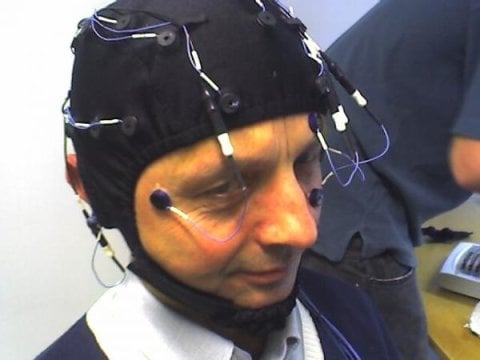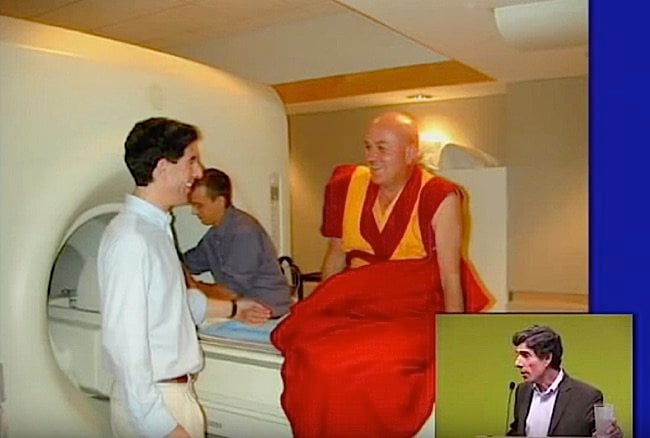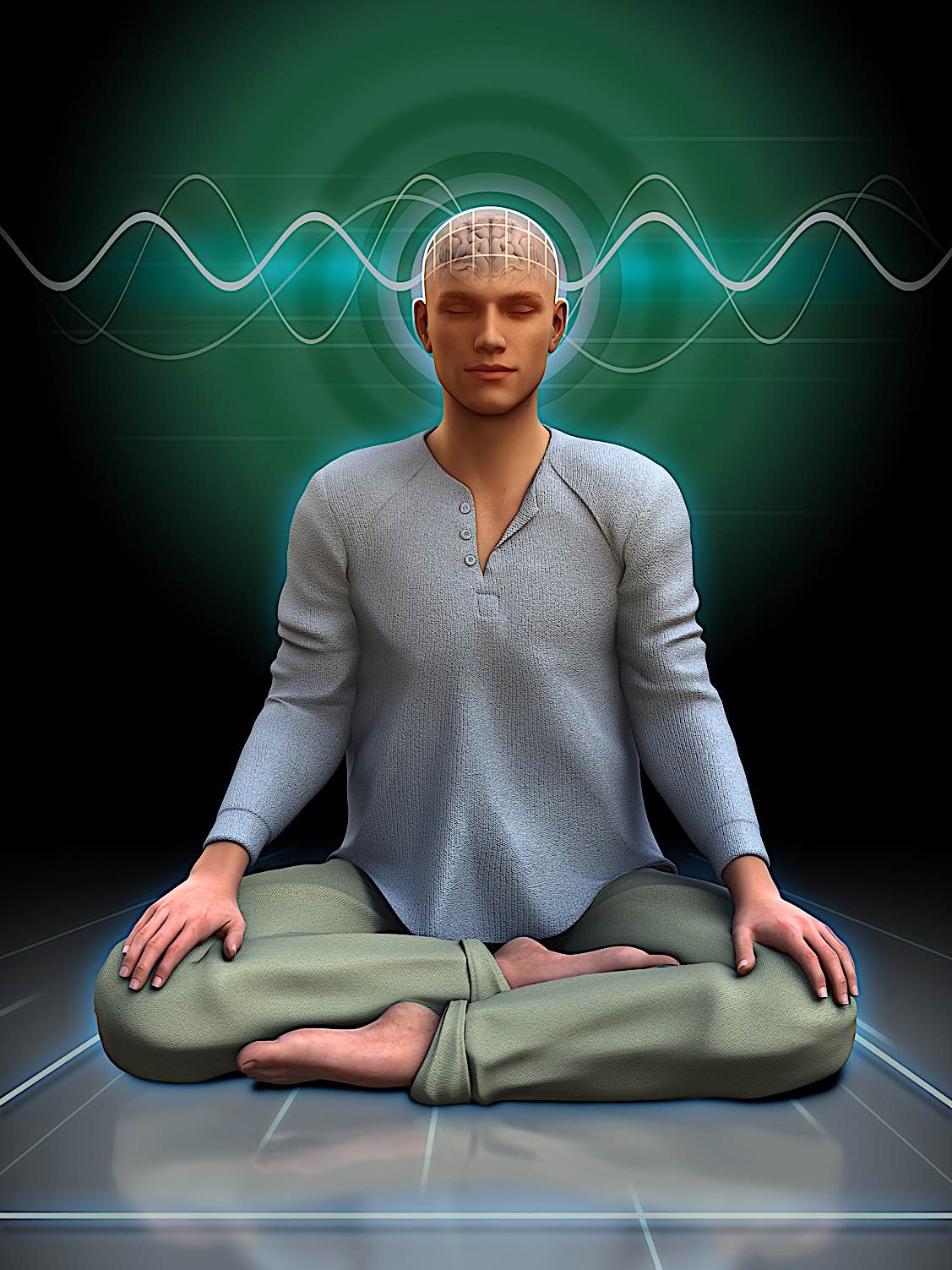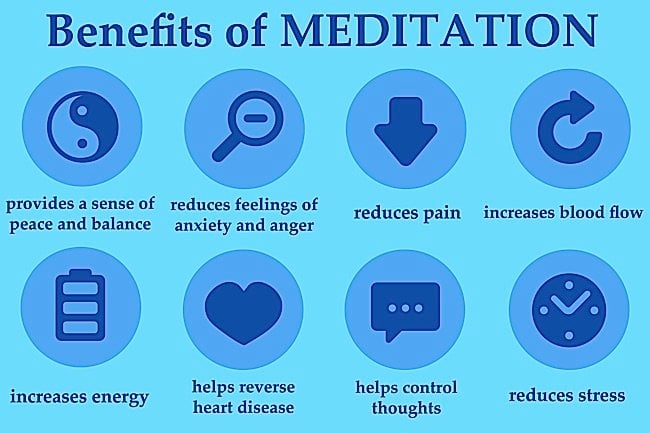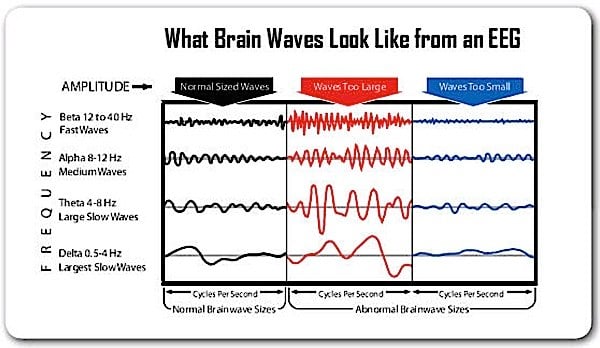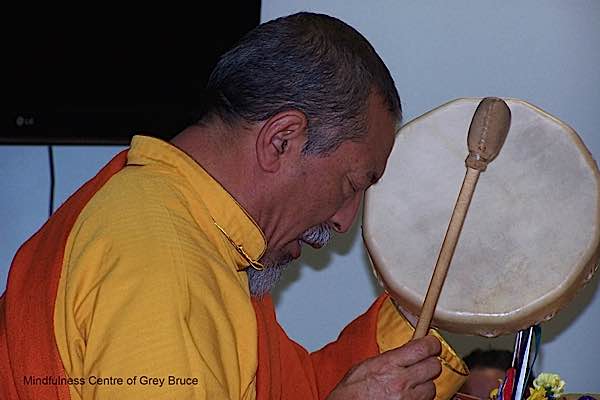[ad_1]
Five key meditation methods can provide signicant health and cognitive benefits by inducing “Theta brainwaves.” — according to numerous studies. Theta is associated with “ideas without censorship” or “ideation” mind mode [2]. It is also one of the secrets to a healthy mind and body.
Despite the science, Theta is notoriously difficult to achieve. According to one study it occurs “more frequently in highly experienced meditation practitioners.”[3]
The different brainwaves we experience, including Beta (survival mode, job mode), Alpha (relaxation mode), Theta (the goal of most meditations) and Beta (dream mode.)
[Five mini how-tos on the five meditation methods at the end of this feature.]
NTNU joint study on Theta waves benefits
“During meditation, theta waves were most abundant in the frontal and middle parts of the brain” reports NTNU in Science Daily. [3] Jim Lagopoulos, of Sydney University (Australia) comments: “Given the popularity and effectiveness of meditation as a means of alleviating stress and maintaining good health, there is a pressing need for a rigorous investigation of how it affects brain function.” He is one of the principles of a joint study between his university and researchers from the Norwegian University of Science and Technology (NTNU) on changes in electrical brain activity during nondirective meditation.
The goal of achieving Theta waves during meditation is difficult but worthwhile. Research shows there are significant health and cognitive benefits. (Simulation in this image only, not actual theta.)
Unfortunately, the health and cognitive benefits of Theta escape many meditators. As Lagopoulous explains:
“Previous studies have shown that theta waves indicate deep relaxation and occur more frequently in highly experienced meditation practitioners. The source is probably frontal parts of the brain, which are associated with monitoring of other mental processes.” Less experienced meditators usually attain an Alpha wave state — relaxed and reflective, but not necessarily as deeply beneficial as Theta.”
In a breakthrough study by NTNU, scientists used a special “cap” that measured brainwaves during meditation.
Theta is not beyond reach, but why do it?
There are many proven ways to achieve Theta — and ultimately altered states of consciousness (ASC or Altered States) — but the question is why do it? Isn’t it just some nostalgic hippie trip, or a detached-from-reality buzz, or a new-age trend? On the contrary, ASC — also called non-ordinary state — is vital to human health, and is the body-mind mechanism for relieving stress, and — according to Psychologists — highly therapeutic. Christa Smith (Psy.D.) explains in Psychology Today [1]:
“Altered states of consciousness, sometimes called non-ordinary states, include various mental states in which the mind can be aware but is not in its usual wakeful condition, such as during hypnosis, meditation, hallucination, trance, and the dream stage.* Altered states can occur anywhere from yoga class to the birth of a child. They allow us to see our lives and ourselves with a broader lens and from different angles of perception than the ordinary mind.”
Meditation, which inspires Theta brainwaves, also inspires insight and ideas. According to Ned Herrman in Scientific American [2]:
People experiencing Theta “are prone to the flow of ideas… The ideation that can take place during the theta state is often free flow and occurs without censorship or guilt. It is typically a very positive mental state.”
Five Main Styles of Meditation to Achieve Theta or the Altered States
The study from NTNU (cited above), used “Acem Meditation, a “nondirective method developed in Norway. They were asked to rest, eyes closed, for 20 minutes, and to meditate for another 20 minutes, in random order. The abundance and location of slow to fast electrical brain waves (delta, theta, alpha, beta) provide a good indication of brain activity.” [3]
Main methods and practices
The main methods fall into various “practice styles,” which could loosely be tagged as:
- Mindfulness.
- Guided meditations and visualization.
- Mantra.
- Sound: binaural sounds, drumming, rattling, singing.
- Repetitive tasks (for example, the Zen practices of sweeping, archery, martial arts).
Each of these breaks down into more detailed methods, for example, mindfulness of perception, mindfulness of breath, and mindfulness of body. Under guided meditation, there are innumerable methods. Shamanistic-style drumming and rattling are just two of many approaches to sonic methods.
Zen Mindfulness can be achieved in many ways, including concentrated activities such as skateboarding or martial arts. See this BW feature on “Riding to Enlightenment.”
But NOT Analytical meditation
Analytical meditation, logic, debate, and other forms of spiritual meditation are not necessarily ideal for generating Theta. They tend to push the mind into either Beta or Alpha. They have their place — as a method of developing wisdom — but they are not the focus of these studies.
A “non-ordinary state” of mind — Theta — is the goal of people pursuing creative insight, health benefits or cognitive development. One healthy mechanism for “non-ordinary state” is built into our daily lives: dreaming and day-dreaming are altered states, and vital to our health. Advanced practitioners often engage in lucid dreaming.
Aside from natural and lucid dreaming, the main “learned” methods are various forms of “non-directed” meditation, which has the added benefits of insight, reflection and blissful mind.
Matthieu Ricard is still smiling after a gruelling, claustrophobic meditation session in an MRI. He is a monk participant in an extensive study on compassion’s effect on happiness and health.
In this feature, we explore these five mains styles of meditation — mindfulness, guided, mantra, sound, and repetitive tasks — all proven methods to achieve altered states of consciousness, without drugs, fasting or other unhealthy tricks. They are so diverse; one is bound to appeal to you.
Emptiness: the common element of the five styles
Meditators often experience a sense of ONENESS with the Universe, and expansiveness often described as “Emptiness.”
Clearly, there is some common element in these five styles. The research from NTNU identified it very precisely:
“Several studies indicate better relaxation and stress management by meditation techniques where you refrain from trying to control the content of the mind. These methods are often described as nondirective, because practitioners do not actively pursue a particular experience or state of mind. They cultivate the ability to tolerate the spontaneous wandering of the mind without getting too much involved. Instead of concentrating on getting away from stressful thought and emotions, you simple let them pass in an effortless way.”
All of the five styles generate a form of “non directed mind.” In Buddhism, this is somewhat akin to the concept of Emptiness. Emptiness does not mean nothingness or non-existence. It means empty of ego, empty of direction, empty of stress — it is also a sense of “fullness” and unity with everything else. When you are mindful, your mind expands. Distant sounds become clear. Your mind expands beyond logical Beta thought.
Expansive Theta mind becomes One with everything, no longer censored or constrained by logical mind and ego.
Genuine cognitive and health — and Dharma — benefits are associated with attaining Theta brainwaves.
Genuine cognitive and health — and Dharma — benefits are associated with attaining Theta brainwaves.
Five methods of self-hypnosis
How can these five methods — including guided visualizations — all be non-directed meditations? All of them have an element of “hypnosis.”
- Mindfulness: clearly non-directed mind applies. You become the observer. You do not try to think, but if you do have thoughts, you observe them. [For more on the science of mindfulness, see the BW feature: “The Science Behind Stilling Your Mind with Mindfulness.”>>]
- Guided meditation and visualization: you allow your mind to be guided — you do not direct, you follow direction. [For the science behind visualization, see: Science: Research proves visualization improves cognitive performance…>>]
- Mantra: sacred sounds repeated over and over until they become “emptiness” of mind. Yet, because a “meaning” is subtly attached to each mantra, it has the hypnotic effect of implanting desired “goals” in the subconscious. (Or, if you don’t accept this definition, it’s still repetitive sound.) [For a story explaining the benefits of mantra, please see “No time for daily practice? Chant a mantra…>>]
- Sound: notably binaural rhythms, but one of the most effective proven methods in various studies are drums (as in shaman drums pounded at a high repetitive beat) and rattles. [See this story on studies reinforcing the “drumming for mindfulness” and its benefits for health, support for cancer, Parkinsons and depression.]
-
Mr Myagi teaches the “Karate Kid” the “Wax on, Wax off” method. Repetitive tasks — washing the car, painting the fence, sweeping the floor, raking the leaves — can induce Theta.
Repetitive Tasks: ever wonder why Zen masters assign novices to sweep repetitively? Are they clean obsessed? Assigning the dirty work to someone else? No, they are engaging in skilful means. Repetitive chores such as sweeping, memorized martial arts routines such as Tai Chi, and even waxing the car can be meditative: “Wax on, wax off” (Mr Miyagi in the Karate Kid movie.) Even skate-boarding can be considered repetitive meditation. [See this unique story on the Zen of skateboarding>>]
All of these are non-directed meditations can induce Theta.
The stress of daily life induces alert, survival BETA.
Ordinary mind (Beta) deliberately induces stress
“Ordinary mind” — in brainwaves classified as BETA, the stress-inducing frequency of our survival “awake” mind — evolved to help keep us alive. It motivates us to act, to work, to gather food, to cope with danger. The ordinary, awake mind induces wakeful stress to help us survive — an evolved stimulation that has its evolutionary roots in our hunter-gatherer beginnings. Ordinary mind also evolved ALPHA brainwaves — the relaxed and reflective mind — once we evolved enough to seek refuge in caves, to build castle walls, or houses with locks.
The known benefits of meditation.
Only at night, in the safety of our caves — our homes — did the mind release the high-alert ordinary mind, and allow a little stress-reducing downtime, in the form of THETA and DELTA brainwaves: THETA during relaxing escapes such as napping, story-telling and song (today, movie watching and stereo) and DELTA during dreaming and sleep — both achieved, mostly, in the relative serenity that comes from a rampart (today, an alarm system.) This is why it is often difficult, for instance, to achieve relaxing THETA or DELTA as a stressed-out patient in the hospital.
Mindless thriller entertainment can induce a form of Theta. It’s escapism that invites “suspended disbelief” — and in some cases, a drowsy state of mind akin to Theta.
Mindless thrillers as meditation?
Ever wonder why silly action-movies and mindless thrillers and comic-book adaption movies are so popular? It’s not that they are “relaxing” in tone and manner; it’s simply because they are a form of escapism. It’s so far removed from our stressful BETA lives, that it genuinely induces an ALPHA state in many of us — relaxed mind— probably similar to the feeling the ancient Greeks must have experienced when they listened to the exciting tales of the gods and heroes. On the other hand, a gritty, artsy, true-to-life biography or war history movie might inspire the opposite — triggering BETA — simply because it resonates with our day-to-day stress-mode.
In fact, going one step further, an over-the-top adventure or comedy movie or novel, while it usually induces an ALPHA state, can trigger THETA. (Yes, that’s you, the movie-goer who drowses slightly during the action movie.) In meditation, the goal is usually either a deep ALPHA (highly relaxed and reflective mind, for instance in Samatha meditation) or light THETA (visualization meditation.) So, although an escapist myth, movie or novel will not replace meditation, it’s certainly “good for you.” Just avoid the too-real, too-historical, too frightening stress-inducing stories unless you’re ready to jump back up to stressful BETA.
When an EEG is taken of a person focused on drumming at four beats per second, the brainwave will inevitably go to Theta or least Alpha. An experienced Buddhist monk or meditator during silent mindfulness meditation would likewise achieve Theta brain waves in the low cycles. Theta brainwaves occur between 4 – 7 Hz or 4 – 7 cycles per second and is associated with meditative serenity, daydreaming, fantasy, imagination, ideas, inspiration. Deep Theta is often achieved by very expert meditators, and could almost be described as lucid dreaming. For the rest of us, mindfulness tends to result only in a light Alpha wave.
Feeling safe and secure helps change our wave pattern
A sense of safety and security helps coax the BETA brain to release its “red alert” state. Laughter, song, silly movies, good food, friends — all these help us feel safe and secure and encourages a wholesome ALPHA relaxed mind. Ultimately, for real health benefits, we hope to achieve a deep ALPHA or a light THETA. Meditation, in a safe environment, is certainly one of the surest ways to induce stress-relieving brainwaves. With mindfulness, you might also accidentally slip into DELTA (sleep mode) but if you’re doing formal Zazen retreat watch out! — whack on the shoulder from the teacher might wake you back up.
Drumming a fast, regular beat has been shown in numerous studies to induce Theta with associated health, meditational and cognitive benefits. The simple method has been used since the time of ancient shamans and is still used today in many traditions. Above: H.E. Zasep Rinpoche drums for mindfulness at a retreat. For a full story on the science behind “drumming for mindfulness, see>>
Meditational Altered States: THETA mind
From a meditational point of view — and certainly from a Buddhist perspective — ASC is the mechanism that makes meditation valid as both a stress-reliever and a doorway to insight. Altered States — specifically THETA brainwaves — is not the goal, it is only the mechanism. The goal of meditation can vary: health, stress-relief, insight (in Buddhism, “wisdom”), relief from depression, and, specific to Vajrayana and Buddhism: achieving “bliss and wisdom in union.” But the mechanism for achieving most of these is a state of THETA.
In Vajrayana, it is sometimes said that altered state is the horse, and insight is the destination. In other traditions, such as shamanism, the drum might replace the horse — the drum being the audible mechanism helping achieve ASC — and “meeting” a spirit guide might be the goal. In real yoga — not the one-hour gym class — the mechanism and goals are similar.
Mantras and meditation can be done almost anywhere. Mingyur Rinpoche coaches us to at least do a few seconds or minutes of meditation at a time, instead of waiting for that long session that never comes.
Office Mindfulness: Theta helps cognition
Although we’re tuned to BETA brainwaves in work and survival mode when out of our safe-places, many problems are best solved when the mind is at least in “reflective” mode — ALPHA brainwaves. This is why office workers often engage in short mindfulness sessions throughout the day. Not only for work problems but for “healing” and therapy, Altered States of Consciousness is often superior. Christa Smith, in Psychology Today, explains [1]:
“I often witness clients relying too heavily on the ordinary mind. They painstakingly analyze themselves and their problems with little payoff, as if the ordinary mind is the only and best tool for healing. Adele was one such client. She was a 45 year-old mother of two who suffered from depression related to aging. She was highly intelligent and could articulate perfectly why being in her forties bothered her so much. But as much as she tried to convince herself it wasn’t true, she could not shake the idea that her life was essentially over, that all of the good times were in the past. She struggled to overcome this belief, which was at the heart of her depression, but made little progress.”
Explaining brainwaves: electrical power?
One way to explain brainwaves is with electricity. In Scientific American, Nedd Herrman explains brainwaves this way[2]:
In several studies, MRI scans are used to visually measure the significant changes mindfulness meditation can achieve.
“Even though this electrical power is very limited, it does occur in very specific ways that are characteristic of the human brain. Electrical activity emanating from the brain is displayed in the form of brainwaves. There are four categories of these brainwaves, ranging from the most activity to the least activity. When the brain is aroused and actively engaged in mental activities, it generates beta waves. These beta waves are of relatively low amplitude and are the fastest of the four different brainwaves. The frequency of beta waves ranges from 15 to 40 cycles a second. Beta waves are characteristics of a strongly engaged mind. A person in active conversation would be in beta. A debater would be in high beta. A person making a speech, or a teacher, or a talk show host would all be in beta when they are engaged in their work.”
He goes on to describe ALPHA as the opposite of BETA:
“Where beta represented arousal, alpha represents non-arousal. Alpha brainwaves are slower, and higher in amplitude. Their frequency ranges from 9 to 14 cycles per second. A person who has completed a task and sits down to rest is often in an alpha state. A person who takes time out to reflect or meditate is usually in an alpha state. A person who takes a break from a conference and walks in the garden is often in an alpha state.”
THETA: “ideation mode”: ideas flow without censorship
When those frequency cycles per second drop to between five and eight, we move into THETA, at first a light day-dream-like state, what Nedd Herrmann calls “ideation” mode. Repetitive tasks — drumming, mantras, watching or counting breath, jogging and running, or even driving long miles of monotonous straight highway — can induce THETA. (Obviously, not desired when driving those highways!)
Chanting and disciplined ritual is still important in many schools of Zen. Repetitive actions — the powerful sound of the fish drum (foreground) and chanting a repetitive mantra or praise — are proven methods to induce Theta. Here, Zen students chant with the famous “fish drum.” For a feature on Fish Drums see>>
This is why some of your best ideas occur when bathing, showering, jogging, or meditating. The relaxed mind, slower than ALPHA is “prone to flow of ideas,” according to Herrmann. Even brushing your hair, or sweeping the floor, or any automatic, repetitive task can inspire your most creative moments. Hermann describes THETA:
“It is a state where tasks become so automatic that you can mentally disengage from them. The ideation that can take place during the theta state is often free flow and occurs without censorship or guilt. It is typically a very positive mental state.”
Importantly, formal meditative practice is specifically designed to quickly induce THETA — or in some cases light DELTA.
Dream Yoga or Lucid Dreaming for the purpose of Dharma practice is particularly effective helping us understand the true nature of reality. For a story on Lucid Dreaming, see>>
DELTA: dream mode
Lighter DELTA could be thought of as daydream mode, but in meditation is associated with visualization practice and LUCID dreaming. While THETA is ideal for stress-reducing and idea/insight, DELTA has a more specialized meditative mission: deeply altered states of consciousness that allow us to see beyond conventional reality biased by conditioning.
What Buddha Taught
Buddha taught many methods for loosening the grip of conditioning on our fragile psyches. We grew up conditioned by pain and suffering — from our wailing emergence from the safety of our mother’s womb to the often-traumatic experiences that follow. We also develop attachments to those things we enjoy. The Four Noble Truths and the Eightfold Path provide the initial teachings on overcoming this conditioning that keeps us in a “suffering” state of mind.
Other methods include meditative methods, including visualization, that helps us see the world without the lens of our “conditioning.”
In the dream world, we can fly; when awake gravity takes hold. When we visualize the merit field of Enlightened Beings, we see a Pure Land as it could be if we removed attachments, conditioning and clinging; when awake, we see endless pain and suffering.
Even pragmatically, when our therapist coaches us with a guided meditation, to help us overcome some specific trauma, we are experiencing Theta.
Quick How-Tos
Although we have more extensive “how-tos” on these various practices, here is a quick “cheat sheet” to inducing Theta through the Five Styles of Altered States Meditation.
1. Mindfulness
It might seem that mindfulness is the “easiest” of these practices. In fact it is a practice that eludes many, including some experienced meditators. While guided meditation and drumming can be quickly approached, mindfulness is — by definition — not easy to instruct. Basically, you sit, stand, walk and try to “disengage” the Beta and Alpha mind by “observing.” As indicated in the above NTNU study, the “observing” mind engages the “frontal parts of the brain, which are associated with monitoring of other mental processes.”
Guru Rinpoche, the great Sage of Tibet, stressed the importance of alone time. Even if you can’t get away to a handy “meditation cave” a close door and a turned-off cell phone makes sense.
So, by way of instruction, sit, stand or walk (in all three cases in a situation where your mind doesn’t have to intervene) and then try to simply observe. Not only do you “observe” what is happening around you — the ticking of the clock, the chirping of the bird — but without engaging with it.
The great teachers would say, “simply be.” Be mindful. Be observant. Be there but not participating. Attempt this for at least 1o minutes. Don’t try to “empty” the mind of thoughts — some meditators try to force this — but simply, instead, observe them. Even if they are stressful, nasty, hateful thoughts. No judgment. Simply observe.
The basic steps could include:
- Sit or stand in a way that is non-involving (comfortable).
- Adopt an upright but comfortable posture.
- Simply observe.
Meditation in the office can make you more productive. Mindfulness during a meeting can result in fewer mistakes. Breathing meditation can calm the stress that inhibits innovation and enthusiasm.
Some people add in additional steps — also a bit counter-intuitive for a process designed to disengage mind. For example:
- Sit comfortably.
- Initially, count your breaths and relax.
- Correct your posture, but remain comfortable.
- Half close or fully close your eyes.
- Watch your breath. Feel it. Observe it. Do not participate.
- Begin to notice, without participating, what is going on around you: sounds, feelings, heat, cold, dampness, itchy skin.
- Observe your mind and its thoughts, but do not participate. Simply let it be. Watch.
- Expand your observation. Try to listen beyond your immediate space.
- Continue observing, without participating as long as you can. If you start participating or correcting random thoughts that bother you. Simply cease and observe. Do not correct.
2. Guided Meditation and Mindfulness
By releasing control (Beta mind) to a guide, we can experience a most intense Theta session. The objective of Vajrayana visualization is to help induce this “open and empty” mind to introduce our minds to the concept that the true nature of reality is not what we think. This idea was first expressed by the Buddha in the great Maha nidana Sutta:
“If this exists, that exists; if this ceases to exist, that also ceases to exist.”
By removing the “eyes” from the observer role, the mind becomes the observer — which changes everything. The guru of Quantum Physics, Niels Bohr explained why science and Shakayamuni see “eye to eye” (so to speak):
“Observations not only disturb what has to be measured, they produce it… We compel a quantum particle to assume a definite position.” In other words, as explained by physicist Pascual Jordan: “we ourselves produce the results of measurements.”
[For a full exploration of this concept, supported by both science and Buddhist thought, see “What does quantum physics have to do with the five Buddhas>>]
You don’t have to involve spiritual visualization to achieve some benefits from this method, but for a Buddhist, Vajrayana visualized meditation is the pinnacle of technique.
The easiest way to experience the power of Vajrayana deity visualization — where we visualize ourselves as perfectly Enlightened beings (a form of positive-reinforcement role play) — is to follow along with a meditation master. Here’s one of our most popular guided visualization videos for visualizing Green Tara, as guided and taught by H.E. Zasep Tulku Rinpoche:
Or for those seeking “healing” reinforcement, here is another popular video with guided visualation of Medicine Buddha:
3. Mantra
Om Mani Padme Hum, the great compassion mantra of Avalokiteshvara.
Any collection of sounds can become a mantra, but in Buddhist meditation, many are profound and meaningful — expressing in sound and rhythm deep truths. Some are open to everyone; others are restricted practices because they require instruction.
The goal of mantra is a little more specific. Although the “mind” is still observer and detached from calculated thought, the repetitive or hypnotic element is a repeated mantra. The sound is repeated hundreds of times. Often, this is combined with visualization — even something simple, such as healing blue light filling your body. Other times, it’s just the sound and a mindful, watching mind.
Mantras in serious practice are usually intoned at a very low, rhythmic pitch, like the beat of a drum. They go beyond the role of rhythm and sound, however. Mantra contains within it a “stated intention.” If you chant the Medicine Buddha mantra, you are likely planting the seed of healing in the mind.
When mind is in Theta, it is highly suggestable. This is why, in psychotherapy, for example, hypnosis is used. Hypnosis, like all of these techniques, opens the mind — not only the “observing mind” and the “learning mind” but also the “receptive mind.”
It is said you can’t implant a hypnotic suggestion that the recipient doesn’t agree with. It’s still your mind and will. But mantra reinforces the positive intention to heal, or live a long life, or receive protective energies.
To experience a mantra anyone can practice, try singing along with the amazing Yoko Dharma, chanting the Amitabha Buddha mantra Om Ami Dewa Hri:
4. Sound: drumming, rattling, chanting
Aside from mantras, which include the added purpose of implanting an intention, other repetitive sounds also induce Theta, notably drums, rattles and chants.
The benefits of sound go beyond some other Theta techniques. Although Theta mind is one of the reasons drumming works in meditation and healing, several studies have revealing benefits:
- Reduces blood pressure, anxiety and stress: a 2014 study published in the Journal of Cardiovascular Medicine.
- Improves cognitive function: 2014 study in the Journal of Huntington’s Disease.
- Pain Reduction: 2012 study published in Evolutionary Psychology
- Improve Immunity: 2011 study published in Alternative Therapies and Health Medicine
- Induces Theta; enhanced meditation: 2004 study published in the Journal Multiple Sclerosis
- Depression and Emotional Disorders: 2001 study published in the Journal of Evidence-Based Complementary and Alternative Medicine
How to drum
Theodore Tsaousidis leading a drumming session at a Buddhist temple.
Drumming, or any form of percussion provides a strong focus on mindfulness. It’s as simple as taking your favourite meditation technique and adding the drum as the focal point, rather than the breath. You can either drum for yourself (which has extra benefits: the live sound of a drum is very moving), or use a drumming MP3 or recording.
The steps are literally 1,2,3:
1. Sit and get comfortable. Alternately, some people prefer to stand or even dance while drumming.
2. Using any drum, beat a regular, monotonous beat. You can beat quickly, which tends to induce a Theta response (helpful for visualization practices in Vajrayana, for example), or slowly. A heart beat, ba-bump, ba-bump, ba-bump has also been identified as therapeutic.
3. Drum for at least 15 minutes. I find 30 better. Simply focus on the beat (rather than your breath). Become the sound. As always, with mindfulness, if the mind drifts, just refocus gently back on the beat. If images appear, just observe. Be the listener (observer).
[For a more detailed exploration of drumming, see “Mindfulness of Drumming”>>
5. Repetitive tasks: wax on, wax off
There is serenity in the broom, the mop or the clothesline. Many people, when they are furious — say, a fight with a significant other — will take refuge in cleaning the house. The repetitive tasks, such as brooming, mopping, vacuuming can be highly therapeutic.
Sweeping the temple is often assigned to monks. It is not considered a chore. It is a practice, a high form of meditation, dedication and good merit.
More formally, in Zen traditions, repetitive tasks are often assigned, such as “sweeping the temple” or weeding the garden. However, instead of simply saying “Go clean the floor” the teacher will actually show a specific hand motion to be used, a direction to sweep and a speed to employ. The mindless repetition is the meditation. It unleashes the Theta mind, in the same way, a monotonous curve-free highway does for a drowsy driver.
To make this work, either receive instruction, or create your own “ritualized” repetitive task. Clean the floor, yes, but do it with a precise, memorized pattern and speed.
Any repetitive task can be therapeutic, but to rise to the standard of meditation and Theta requires an element of ritualization.
NOTES
[1] “Altered States of Consciousness” Psychology Today, Christa Smith Psy.D.
[2] “What is the function of the various brainwaves” Scientific American, Nedd Herrmann
[3] “Brainwaves and meditation” Science Dailey, NTNU research source.
[ad_2]
Source link

